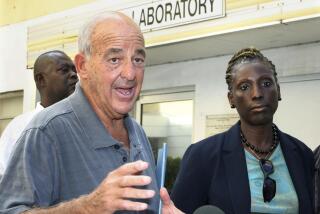Joe McGinniss dies at 71; journalist-author wrote ‘Fatal Vision’

Joe McGinniss, the adventurous and news-making author and reporter who skewered the marketing of Richard Nixon in “The Selling of the President 1968” and tracked his personal journey from sympathizer to scourge of convicted killer Jeffrey MacDonald in the blockbuster “Fatal Vision,” died Monday at a hospital in Worcester, Mass. He was 71.
McGinniss died from complications of prostate cancer, according to his attorney and longtime friend Dennis Holahan.
Few journalists of his time so intrepidly pursued a story, burned so many bridges or more memorably placed themselves in the narrative, whether insisting on the guilt of MacDonald after seemingly befriending him or moving next door to Sarah Palin’s house for a most unauthorized biography of the former Alaska governor and Republican vice presidential candidate.
The tall, talkative McGinniss had early dreams of becoming a sports reporter and wrote books about soccer, horse racing and travel. But he was best known for two works that became touchstones in their respective genres — campaign books (“The Selling of the President”) and true crime (“Fatal Vision”). In both cases, he had become fascinated by the difference between public image and private reality.
McGinniss was born Dec. 9, 1942, in New York and grew up in Rye, N.Y. He graduated from Holy Cross College in 1964 and soon began working as a reporter in Worcester.
He was a columnist for the Philadelphia Inquirer in 1968 when an advertising man told him he was joining Hubert Humphrey’s presidential campaign. Intrigued that candidates had advertising teams, McGinniss was inspired to write a book and tried to get access to Humphrey. The Democrat turned him down, but, according to McGinniss, Nixon aide Leonard Garment allowed him in, one of the last times the ever-suspicious Nixon would permit a journalist so much time around him. Garment and other Nixon aides were apparently unaware, or unconcerned, that McGinniss’ heart was very much with the antiwar agitators the candidate so despised.
The Republican’s victory that fall capped a once-unthinkable comeback for the former vice president, who had declared six years earlier that he was through with politics. Having lost the 1960 election in part because of his pale, sweaty appearance during his first debate with John F. Kennedy and aware of his reputation as a partisan willing to play dirty, Nixon had restricted his public outings and now presented himself as a new and more mature candidate.
McGinniss was far from the only writer to notice Nixon’s reinvention, but few offered such raw and unflattering details. “The Selling of the President” was a sneering rebuttal to Theodore H. White’s stately “Making of the President” campaign books. It revealed Nixon aides, including Roger Ailes, now president of Fox News, disparaging vice presidential candidate Spiro Agnew, drafting memos on how to fix Nixon’s “cold” image and debating which black man — only one would be permitted — was right for participating in a televised panel discussion.
Historian David Greenberg wrote in “Nixon’s Shadow,” published in 2003, that McGinniss “sneaked in under the radar screen, presenting himself to Nixon’s men as such an insignificant fly on the wall that they never thought to swat him away.”
“If White was the voice of the liberal consensus, with its sonorous even-keeled wisdom,” Greenberg wrote, “McGinniss was an emissary from the New Journalism, with his countercultural accents, youthful iconoclasm and nonchalant willingness to bare his left-leaning political views.”
“The Selling of the President” was published in 1969, spent months on the New York Times’ best-seller list and made McGinniss an eager media star. He quit the Inquirer and followed more personal interests, including writing a novel, “The Dream Team.”
In 1979, he was a columnist for the Los Angeles Herald-Examiner when an argument without end was born: McGinniss was approached by MacDonald, a fellow California resident, about a possible book on the 1970 killings for which the physician and former Green Beret was being charged.
In the early hours of Feb. 17, 1970, MacDonald’s pregnant wife and two small children were stabbed and beaten to death at the family’s home in Fort Bragg, N.C. The date, location and identities of the victims are virtually the only facts of the case not in dispute.
MacDonald, who sustained a punctured lung and minor injuries, had insisted that the house had been overrun by a gang of drug-crazed hippies chanting slogans such as “Acid is groovy” and writing “PIG” in blood on a bedroom wall, a murderous rampage seemingly inspired by the then-recent Charles Manson killings.
But investigators suspected otherwise, believing that MacDonald had killed his family and arranged the apartment to make it appear that others had committed the crime. MacDonald was initially cleared of the charges, then indicted and brought to trial in 1979. He was found guilty and sentenced to three consecutive life terms.
“Fatal Vision,” published in 1983, became one of the most widely read and contested true crime books in history. McGinniss wrote not just of the case but of his own conclusions. He had at first found MacDonald charming and sincere but came to believe he was a sociopath who had committed the killings while in a frenzied state brought on by diet pills.
McGinniss’ findings weren’t welcomed by MacDonald or by some fellow journalists. MacDonald sued in 1987, alleging McGinniss had tricked him by pretending to believe in his innocence. He received an out-of-court settlement of $325,000. New Yorker writer Janet Malcolm cited McGinniss as a prime case of the reporter as a “kind of confidence man, preying on people’s vanity, ignorance, or loneliness, gaining their trust and betraying them without remorse.”
McGinniss wrote in his defense: “The attempt to manipulate through ‘cons and lies’ was — it seems clear to me now in retrospect — something Jeffrey MacDonald engaged in with me. Appearance of the book was forceful proof he had not succeeded.”
Italie writes for the Associated Press.
More to Read
Start your day right
Sign up for Essential California for the L.A. Times biggest news, features and recommendations in your inbox six days a week.
You may occasionally receive promotional content from the Los Angeles Times.






